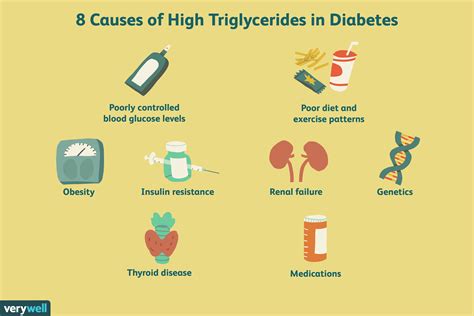Intro
Triglycerides are a type of fat found in the blood, and they play a crucial role in the body's energy production. When we eat, our body converts any calories it doesn't need immediately into triglycerides, which are stored in our fat cells. Later, hormones release triglycerides for energy between meals. Having a normal range of triglycerides is essential for maintaining good health, as high levels can increase the risk of heart disease, stroke, and other cardiovascular conditions. In this article, we will delve into the world of triglycerides, exploring what they are, why they are important, and how to maintain a healthy level.
Triglycerides are an essential part of our diet, and they can be found in various food sources, including meats, dairy products, and oils. However, having too many triglycerides in the blood can be harmful. The American Heart Association recommends that adults have their triglyceride levels checked every five years, starting at age 20. This is especially important for individuals who have a family history of heart disease, are overweight, or have high blood pressure. By understanding what triglycerides are and how they affect our health, we can take steps to maintain a healthy level and reduce our risk of cardiovascular disease.
Maintaining a healthy triglyceride level is crucial for overall health and well-being. When triglyceride levels are too high, it can lead to the development of fatty liver disease, pancreatitis, and other health problems. On the other hand, having low triglyceride levels can also be problematic, as it can lead to malnutrition and other health issues. Therefore, it is essential to understand the normal range of triglycerides and take steps to maintain a healthy level. In this article, we will explore the normal range of triglycerides, the risks associated with high triglyceride levels, and provide tips on how to maintain a healthy level.
What are Triglycerides?

How are Triglycerides Measured?
Triglyceride levels are typically measured using a blood test, which is usually done after an overnight fast. The test measures the amount of triglycerides in the blood, and the results are usually reported in milligrams per deciliter (mg/dL). The normal range of triglycerides varies depending on the laboratory and the individual's age and sex. However, in general, a triglyceride level of less than 150 mg/dL is considered normal, while a level of 150-199 mg/dL is considered borderline high, and a level of 200 mg/dL or higher is considered high.Normal Range of Triglycerides

Risks Associated with High Triglyceride Levels
High triglyceride levels can increase the risk of heart disease, stroke, and other cardiovascular conditions. When triglyceride levels are too high, it can lead to the development of fatty liver disease, pancreatitis, and other health problems. High triglyceride levels can also increase the risk of developing type 2 diabetes and certain types of cancer. Additionally, high triglyceride levels can cause symptoms such as: * Fatigue * Weakness * Shortness of breath * Chest pain * Swelling in the legs and feetCauses of High Triglyceride Levels

Tips for Maintaining a Healthy Triglyceride Level
Maintaining a healthy triglyceride level is crucial for overall health and well-being. Here are some tips for maintaining a healthy triglyceride level: * Eat a healthy diet: Focus on eating a diet rich in fruits, vegetables, whole grains, and lean protein sources * Exercise regularly: Aim for at least 150 minutes of moderate-intensity exercise per week * Maintain a healthy weight: Losing weight if you are overweight or obese can help lower triglyceride levels * Limit saturated and trans fats: Avoid eating foods high in saturated and trans fats, such as red meat, full-fat dairy products, and processed snacks * Choose healthy fats: Focus on eating foods rich in healthy fats, such as avocados, nuts, and olive oilBenefits of Maintaining a Healthy Triglyceride Level

Practical Examples of Maintaining a Healthy Triglyceride Level
Here are some practical examples of maintaining a healthy triglyceride level: * Start your day with a healthy breakfast, such as oatmeal with fruit and nuts * Incorporate physical activity into your daily routine, such as taking a walk during your lunch break * Limit your intake of saturated and trans fats by choosing lean protein sources and healthy fats * Stay hydrated by drinking plenty of water throughout the day * Get enough sleep each night, aiming for 7-9 hours of sleep per nightStatistical Data on Triglyceride Levels

Conclusion and Final Thoughts
In conclusion, maintaining a healthy triglyceride level is crucial for overall health and well-being. By understanding what triglycerides are, how they are measured, and the normal range, we can take steps to maintain a healthy level. By following a healthy diet, exercising regularly, and limiting saturated and trans fats, we can reduce our risk of heart disease, stroke, and other cardiovascular conditions. Remember to consult with your healthcare provider if you have concerns about your triglyceride level or if you are experiencing symptoms such as fatigue, weakness, or shortness of breath.We encourage you to share your thoughts and experiences with maintaining a healthy triglyceride level in the comments below. Have you found any specific tips or strategies to be helpful in maintaining a healthy level? Do you have any questions or concerns about triglycerides or cardiovascular health? Share your thoughts and let's start a conversation.
What is the normal range of triglycerides?
+The normal range of triglycerides is less than 150 mg/dL. However, the normal range may vary depending on the laboratory and the individual's age and sex.
What are the risks associated with high triglyceride levels?
+High triglyceride levels can increase the risk of heart disease, stroke, and other cardiovascular conditions. Additionally, high triglyceride levels can cause symptoms such as fatigue, weakness, and shortness of breath.
How can I maintain a healthy triglyceride level?
+Maintaining a healthy triglyceride level can be achieved by following a healthy diet, exercising regularly, and limiting saturated and trans fats. Additionally, getting enough sleep, staying hydrated, and managing stress can also help maintain a healthy level.
